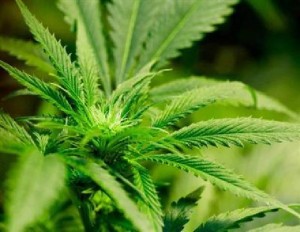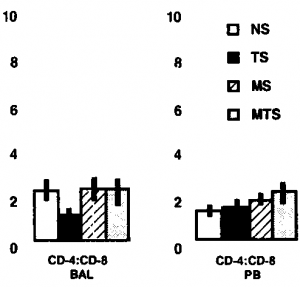Lymphocytic Subpopulation Profiles in Bronchoalveolar Lavage Fluid and Peripheral Blood From Tobacco and Marijuana Smokers: Results
 Although TS and MTS had high concentrations of bronchoalveolar neutrophils, only the comparison between TS and MS was significant. There was a significant effect of both tobacco and marijuana use toward higher AM concentrations (two-way ANCOVA). Tobacco use also had a significant effect of increased concentrations of bronchoalveolar lymphocytes and neutrophils.
Although TS and MTS had high concentrations of bronchoalveolar neutrophils, only the comparison between TS and MS was significant. There was a significant effect of both tobacco and marijuana use toward higher AM concentrations (two-way ANCOVA). Tobacco use also had a significant effect of increased concentrations of bronchoalveolar lymphocytes and neutrophils.
There were no grossly apparent differences in cellular morphologic features among the four study groups, but AM from TS, MS, and MTS could be easily distinguished by the presence of engulfed particulate material.
Table 3 shows the mean percentages and concentrations of bronchoalveolar lymphocytic phenotypes in each of the four study groups. The percentage of bronchoalveolar CD4 cells was significantly lower in TS compared with NS, MS, and MTS, and in MTS compared with NS. In TS, the percentage of CD3 cells was significantly lower compared with NS, and the percentage of CD8 cells was significantly higher compared with MS. Figure 1 shows that TS had a significantly lower bronchoalveolar CD4:CD8 ratio compared with the other groups. Analysis by twoway ANCOVA confirmed a significant tobacco effect of lower percentages of bronchoalveolar CD3 and CD4 cells, and lower bronchoalveolar CD4:CD8 ratios read only http://antimicrobialmed.com. There was a significant marijuana effect of lower bronchoalveolar CD8 cell percentages (twoway ANCOVA). A significant interaction was found between tobacco and marijuana on the percentage of bronchoalveolar CD4 cells and the CD4:CD8 ratio. Among marijuana users, the tobacco effect of lower bronchoalveolar CD-4 cell percentages was less pronounced.
The concentrations of bronchoalveolar CD3 and CD8 cells were significantly higher in TS and MTS than in NS. The concentration of bronchoalveolar CD20 cells was greater in MTS compared with NS. Tobacco, but not marijuana use, was found to have a significant effect of higher bronchoalveolar CD3 and CD8 cell concentrations (two-way ANCOVA). Marijuana use had a significant effect of higher bronchoalveolar CD20 cell concentrations.
Correlation analysis demonstrated no significant relationship between the FEV,/FVC ratio or percent of predicted Deo and any of the bronchoalveolar cellular or lymphocytic phenotypic percentages or concentrations.
Table 3—Bronchoalveolar Lymphocytic Phenotypes in the Four Subject Groups (Data Expressed as Mean ± SEM)
| Nonsmokers | TobaccoSmokers | MarijuanaSmokers | Marijuana and Tobacco Smokers | |
| CD3, % | 78.8 ± 2.9 | 66.813.6f | 73.31 2.4 | 68.512.8 |
| CD4, % | 52.2 ± 2.5 | 31.513.4 | 47.1 13.5 | 41.01 3.6 |
| CDS, % | 28.8 ± 2.4 | 36.7 1 4.21 | 25.412.7 | 26.513.2 |
| CD20, % | 3.510.8 | 3.01 1.1 | 4.510.8 | 4.61 1.1 |
| CD3, x 103/ml | 10.112.1 | 19.4 1 2.51 | 18.113.5 | 29.91 11.7 |
| CD4, x 107ml | 6.61 1.4 | 9.61 1.8 | 12.712.9 | 17.71 7.3 |
| CDS, x 107ml | 3.710.8 | 10.51 1.51 | 5.110.8 | 11.0 1 3.81 |
| CD20, x 107ml | 0.310.15 | 0.610.2 | 1.010.3 | 3.21 1.51 |
Figure 1. Mean bronchoalveolar and peripheral blood CD4:CD8 ratios in nonsmokers (NS), tobacco smokers (TS), marijuana smokers (MS), and marijuana and tobacco smokers (MTS). CD4 identifies helper/inducer cells and CDS identifies suppressor/ cytotoxic cells. The bronchoalveolar CD4:CD8 ratio among TS was significantly lower compared with NS, MS, and MTS. The peripheral blood CD4:CD8 ratio among MS and MTS was significantly higher compared with NS and TS.

Leave a Reply